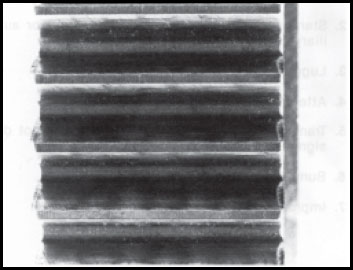Leqa lalai ni vakarorogo Eaton taranisimisani iyaya & Se na moto
Clashing na iyaya
Snubbing and clashing gears while shifting are frequent abuses to which unsynchronized transmissions are subjected. Light snubbing will do little damage. The real damage is done by the hard clash shift caused by engaging gears which are far out of synchronization. This can break pieces of metal from the ends of the clutching teeth. Clashing gears can be traced to one of three causes:
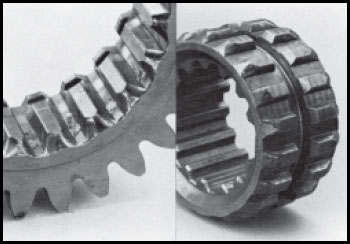
Snubbed na Clutching iyaya vakasequruqurubati
1. Vagolei na cala
This applies to drivers who are not familiar with the shift pattern or have not learned the RPM spread between shifts.
2. Kalaji
Clashing when starting up in first or reverse gear can be caused by insufficient clutch clearance or a dragging clutch not releasing properly. This makes the transmission countershafts and mainshaft gears continue rotating while the clutch pedal is depressed. Clashing results when the nonrotating sliding clutch is forced to mesh with a rotating mainshaft gear. Double clutching during lever shifts will also reduce snubbing and clashing.
3. Inertial na kaukauwa
Countershafts kei na iyaya ni mainshaft sa dau ni taura mai na 3 me 5 na sekodi me tarova na veiveisau talega ni oti ni sa daumaka na kalaji. Saga tiko me mesh e dua na iyaya ni kalaji vata kei na dua na iyaya ni mainshaft ni bera na mainshaft iyaya tacegu ena basika ga na clashing. Kevaka e sega ni vakaiyaragitaki na taranisimisani vata kei na dua na kalaji dovia se dovia ni countershaft, e yaga kina me cegu vakalailai e vica na sekodi oti vakayalolailaitaka na ibutubutu ni kalaji ni bera ni tovolei tiko na siri taumada ni na taranisimisani.
Makisi ni buli iyaya
Sometimes gears are replaced or thought to be defective because of marks left on the gear by manufacturing processes. Oqo na blemishes, Ia, do not contribute to gear failure and the gear should not be replaced because of these marks.
Hob Makisi
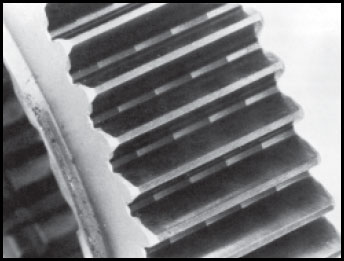
These are cutting marks or lines formed during the initial cutting of the gear teeth. Hob marks on the tooth face will be removed by the shaving process, but hob marks in the root of the tooth will most likely remain, and may be found even on gears with much wear on them.
Makisi ni Lalai
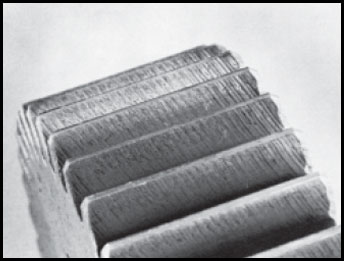
The shaving operation leaves distinct diagonal marks on the face of the gear tooth. These marks can be distinguished from scoring marks by the fact they are diagonal, while scoring marks are more nearly vertical. Most shaving marks are removed during normal gear operation.
Iyaya na rorogo vela ni taqiri ena vucesa
Mainshaft gears are designed to have a specified amount of axial clearance which allows them to rotate freely on the mainshaft. The amount of clearance is governed by the use of washers. Rawa ni o virikotora na voravora idling na idini cake vibrations, causing the mainshaft gears to rattle as they strike mating gears. This condition can usually be cured by improving the idling characteristics of the engine. Tolerance washers may have to be changed to bring the axial gear clearance to within tolerance on high mileage units. See the service manual for procedure and specifications.
Twist ni moto kei na Fracture
Failure of transmission shafts through fracturing or twisting is caused when stresses are imposed on them which are greater than they were designed to withstand. The main causes for these failures are:
- Cala na iwalewale clutching.
- Tekivu rui levu ni iyaya.
- Lugging.
- Nona tovolea tiko me tekivu mai na butuka lokataki.
- Transmission used for application it was not designed to withstand.
- Bumping ki na wavu ni veitokoni.
- Cala na davoraki ni adjustable na qiqi 5th.
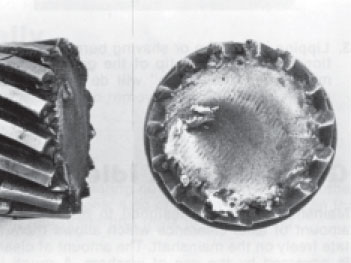
Fractured Mainshaft
Me vaka ga na iyaya vakasequruqurubati, shafts may fracture as a result of fatigue or impact.
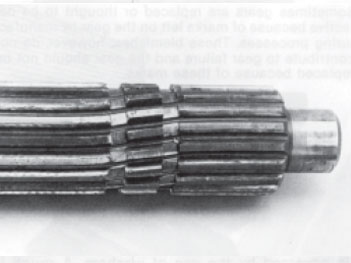
E cowiritaka Mainshaft
Loads not severe enough to cause shaft fractures may cause the shaft to twist.
E dua tiki ni biaulivaliva o na gadreva e tu vei! Dua ga na siga vakauyaya tu, e vuravura raraba.
GADREVA NA GALALA NA VEITOKONI MAI VUA E DUA NA KENADAU?

